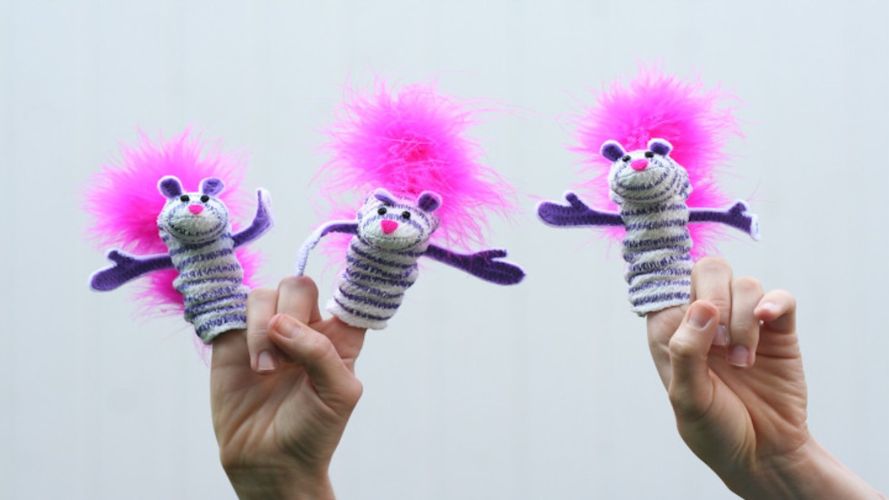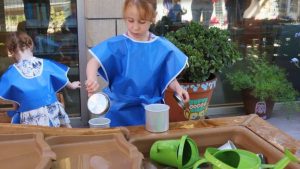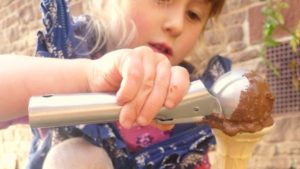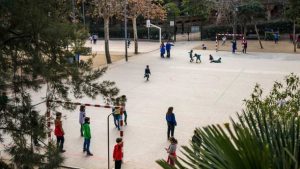Fingerplays, handclapping, and rhythmic song are systems of the very first formal learning for children. These are sometimes nonsensical, always produce giggles and laughter, and somehow convey to a toddler or child something of educational value.
We’ve reviewed some of the most popular fingerplays to help parents and grandparents convey these treasures, some of which have been around for hundreds of years in some form or other. You’ll also find videos that demonstrate the tunes and accompanying gestures. Have fun remembering your own long-ago days with these truly vintage games for preschoolers. Pass it on!
#1 Pat-a-cake
Pat-a-cake, pat-a-cake, baker’s man.
Bake me a cake as fast as you can
Pat it, and roll it, and mark it with “B”
And put it in the oven for Betty and me!
Pat-a-Cake is most generally the first fingerplay taught to babies. This piece originated in England in the late 17th century. Most modern versions use the word Baby rather than Betty or the original Tommy.
#2 Where is Thumbkin?
Where is Thumbkin?
Where is Thumbkin?
Here I am!
Here I am!
How are you today, sir?
Very well, I thank you
Run away
Run away
Where is Pointer?
Where is Pointer?
Here I am!
Here I am!
How are you today, sir?
Very well, I thank you
Run away
Run away
Where is Middleman?
Where is Middleman?
Here I am!
Here I am!
How are you today, sir?
Very well, I thank you
Run away
Run away
Where is Ringman?
Where is Ringman?
Here I am!
Here I am!
How are you today, sir?
Very well, I thank you
Run away
Run away
Where is Pinkie?
Where is Pinkie?
Here I am!
Here I am!
How are you today, sir?
Very well, I thank you
Run away
Run away
Thumbkin is also a very early rhyme. The purpose is to teach the toddler the anatomy of the hand. That may seem like a minor achievement, but if you instruct a child to put her middle finger and thumb together to make a snapping sound, having a word for the five digits can be quite handy.
#3 Doors on the bus
The wheels on the bus go round and round,
round and round,
round and round.
The wheels on the bus go round and round,
all through the town.
The wipers on the bus go Swish, swish, swish;
Swish, swish, swish;
Swish, swish, swish.
The wipers on the bus go Swish, swish, swish,
all through the town.
The horn on the bus goes Beep, beep, beep;
Beep, beep, beep;
Beep, beep, beep.
The horn on the bus goes Beep, beep, beep,
all through the town.
The doors on the bus go open and shut;
Open and shut;
Open and shut.
The doors on the bus go open and shut;
all through the town.
The Driver on the bus says “Move on back,
move on back, move on back;”
The Driver on the bus says “Move on back”,
all through the town.
The babies on the bus says “Wah, wah, wah;
Wah, wah, wah;
Wah, wah, wah”.
The babies on the bus says “Wah, wah, wah”,
all through the town.
The mommies on the bus says “Shush, shush, shush;
Shush, shush, shush;
Shush, shush, shush.”
The mommies on the bus says “Shush, shush, shush”
all through the town.
Wheels on the Bus is a favorite among preschoolers. At about the age of three, children become aware of a place called school. Maybe they have siblings in school, or the child wistfully watches the neighborhood children get on the yellow bus every morning. Most desperately want to the join the crowd. This is a good long-form poem accompanied by fun hand movements. It develops memory in both physical and mental forms. Warning, however, kids usually never want to stop singing the song, especially in your car.
#4 Head, shoulders, knees and toes
Head, shoulders, knees and toes, knees and toes.
Head, shoulders, knees and toes, knees and toes.
And eyes and ears and mouth and mouth and nose.
Head, shoulders, knees and toes, knees and toes, knees and toes.
March, march, march.
Let us all march.
March, march, march.
Get your body charge!
Head, shoulders, knees and toes, knees and toes.
Head, shoulders, knees and toes.
And eyes and ears and mouth and nose.
Head, shoulders, knees and toes, knees and toes.
Jump, jump, jump.
Let’s all jump.
Jump, jump, jump.
Make your muscle pump!
Head, shoulders,…
An exercise song, ‘Head, Shoulders, Knees, and Toes’ is a great way to wake up in the morning. The song with the movements really does give little ones a workout. In addition, the little ones can learn parts of their bodies in a fun way. This morning ritual will establish a routine that promotes physical fitness right from the start.
Learn more about the history of Head, Shoulders, Knees and Toes
#5 Do your ears hang low?
Do your ears hang low?
Do they wobble to and fro?
Can you tie ’em in a knot?
Can you tie ’em in a bow?
Can you throw ’em o’er your shoulder, like a continental soldier?
Do your ears hang low?
Do your ears stand high?
Do they reach up to the sky?
Do they droop when they are wet?
Do they stiffen when they’re dry?
Can you wave them at your neighbor With an element of flavor?
Do your ears stand high?
Do your ears flip-flop?
Can you use them as a mop?
Are they stringy at the bottom?
Are they curly at the top?
Can you use them for a swatter?
Can you use them for a blotter?
Do your ears flip-flop?
Do your ears stick out?
Can you waggle them about?
Can you flap them up and down, as you fly around the town?
Can you shut them up for sure, when you hear an awful bore?
Do your ears stick out?
Do your ears give snacks?
Are they all filled up with wax?
Do you eat it in the morning?
Do you eat it in the bath?
Do you eat it with a scone, Or do you eat it on its own?
Do your ears give snacks?
This is a silly song; the kind preschoolers love the absolute best. This version references the ears of an elephant. The more outrageous the lyrics, the more the kids love it. The tune is catchy and the hand motions are extended giving another physical exercise outlet.
#6 Hickory, dickory, dock
Hickory Dickory Dock
The mouse ran up the clock
The clock struck one
The mouse ran down
Hickory Dickory Dock!
Hickory Dickory Dock
The mouse ran up the clock
The clock struck two
The mouse ran down
Hickory Dickory Dock!
Hickory Dickory Dock
The mouse ran up the clock
The clock struck three
The mouse ran down
Hickory Dickory Dock!
Hickory Dickory Dock
The mouse ran up the clock
The clock struck four
The mouse ran down
Hickory Dickory Dock
This is an old song that teaches both counting and reading the clock. By about age four, kids should be familiar with an analog clock, not the digital version. Handing a wall clock on the wall of the children’s bedroom and using it with the song will reinforce the learning.
#6 Five little ducks
Five little ducks
Went out one day
Over the hill and far away
Mother duck said
“Quack, quack, quack, quack.”
But only four little ducks came back.
Four little ducks
Went out one day
Over the hill and far away
Mother duck said
“Quack, quack, quack, quack.”
But only three little ducks came back.
Three little ducks
Went out one day
Over the hill and far away
Mother duck said
“Quack, quack, quack, quack.”
But only two little ducks came back.
Two little ducks
Went out one day
Over the hill and far away
Mother duck said
“Quack, quack, quack, quack.”
But only one little duck came back.
One little duck
Went out one day
Over the hill and far away
Mother duck said
“Quack, quack, quack, quack.”
But none of the five little ducks came back.
Sad mother duck
Went out one day
Over the hill and far away
The sad mother duck said
“Quack, quack, quack.”
And all of the five little ducks came back.
#7 This old man
This old man, he played one,
He played knick-knack on my thumb;
Knick-knack paddywhack,
Give a dog a bone,
This old man came rolling home.
This old man, he played two,
He played knick-knack on my shoe;
Knick-knack paddywhack,
Give a dog a bone,
This old man came rolling home.
This old man, he played three,
He played knick-knack on my knee;
Knick-knack paddywhack,
Give a dog a bone,
This old man came rolling home.
This old man, he played four,
He played knick-knack on my door;
Knick-knack paddywhack,
Give a dog a bone,
This old man came rolling home.
This old man, he played five,
He played knick-knack on my hive;
Knick-knack paddywhack,
Give a dog a bone,
This old man came rolling home.
This old man, he played six,
He played knick-knack on my sticks;
Knick-knack paddywhack,
Give a dog a bone,
This old man came rolling home.
This old man, he played seven,
He played knick-knack up in Heaven;
Knick-knack paddywhack,
Give a dog a bone,
This old man came rolling home.
This old man, he played eight,
He played knick-knack on my gate;
Knick-knack paddywhack,
Give a dog a bone,
This old man came rolling home.
This old man, he played nine,
He played knick-knack on my spine;
Knick-knack paddywhack,
Give a dog a bone,
This old man came rolling home.
This old man, he played ten,
He played knick-knack once again;
Knick-knack paddywhack,
Give a dog a bone,
This old man came rolling home.
‘This Old Man’ is a treasure trove of early childhood education. First, the child’s memory is challenged. This is a long song with difficult lyrics. Those difficult-to-pronounce nonsense words are there for a good reason. They teach the pronunciation of English. Who knew? There is counting to ten and body parts naming just to top it off. One of the historic greats of fingerplays for preschoolers.
#8 Down by the bay
Down by the bay
Where the watermelons grow
Back to my home
I dare not go
For if I do
My mother will say
“Did you ever you ever see a goose
kissing a moose?”
Down by the bay
Down by the bay
Where the watermelons grow
Back to my home
I dare not go
For if I do
My mother will say
“Did you ever see a whale
With a polka dot tail?”
Down by the bay
Down by the bay
Where the watermelons grow
Back to my home
I dare not go
For if I do
My mother will say
“Did you ever see a fly
Wearing a tie?”
Down by the bay
Down by the bay
Where the watermelons grow
Back to my home
I dare not go
For if I do
My mother will say
“Did you ever see a bear
Combing his hair?”
Down by the bay
Down by the bay
Where the watermelons grow
Back to my home
I dare not go
For if I do
My mother will say
“Did you ever see a llama
Eating pajamas?”
Down by the bay
Down by the bay
Where the watermelons grow
Back to my home
I dare not go
For if I do
My mother will say
“Did you ever have a time
When you couldn’t make a rhyme?”
Down by the bay
Down by the bay
‘Down by the Bay’ is a real, grown-up song. The music and lyrics are fun and pleasant to listen to. If you have talented singers, you might teach them how to harmonize or sing the song in rounds. This is a piece for the older kids, the one they will take to kindergarten with them and show off when the song is presented by the teacher. Bonus: it is one of the least repetitive and irritating children’s songs. You’ll probably enjoy it a great deal.






